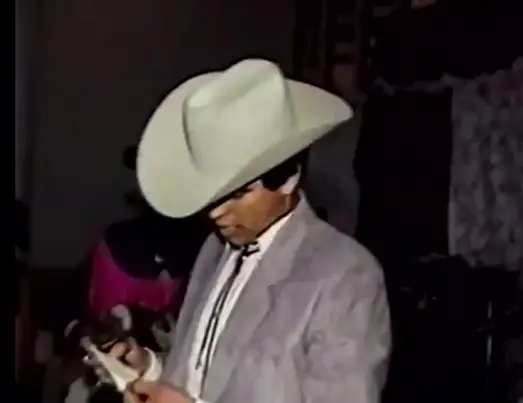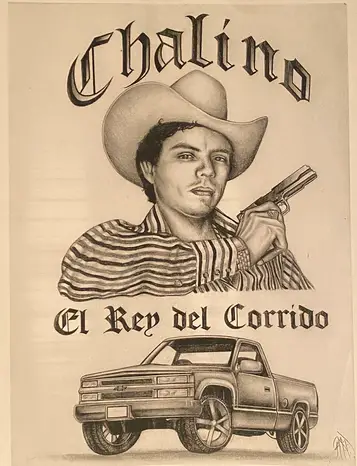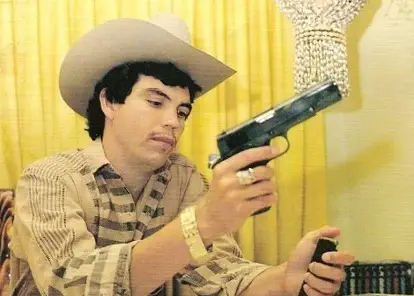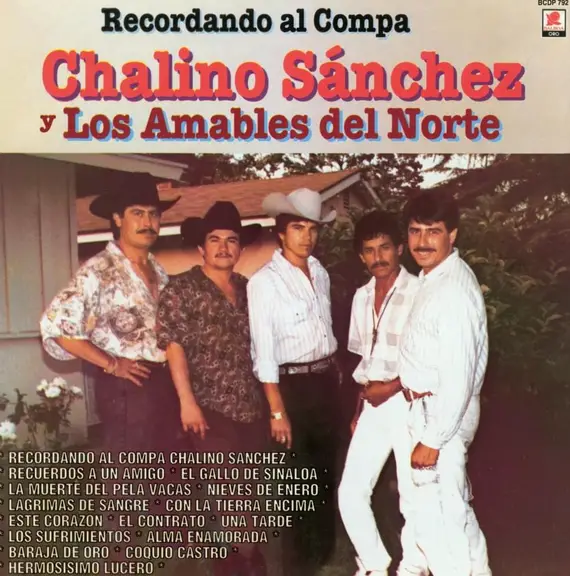Podcast: Play in new window | Download
Subscribe: Apple Podcasts | RSS
 On the fateful night of May 15, 1992, rising Mexican music star Chalino Sánchez found himself at the Salón Bugambilias in Culiacán, Sinaloa, enveloped by an atmosphere thick with foreboding. Amidst the crowd, a mysterious note appeared in his hand, whispered into existence by an unknown sender. Speculation swirled that it bore a sinister message—a harbinger of doom promising his demise after the song’s final note, yet the truth of this message still remains veiled in shadow.
On the fateful night of May 15, 1992, rising Mexican music star Chalino Sánchez found himself at the Salón Bugambilias in Culiacán, Sinaloa, enveloped by an atmosphere thick with foreboding. Amidst the crowd, a mysterious note appeared in his hand, whispered into existence by an unknown sender. Speculation swirled that it bore a sinister message—a harbinger of doom promising his demise after the song’s final note, yet the truth of this message still remains veiled in shadow.
In a moment frozen in time, captured on a haunting amateur video recording, Chalino’s demeanor shifted, his face contorted by shock as he crumpled the note with trembling hands. With a steely resolve, the 31-year-old singer proceeded to serenade the audience with “Alma Enamorada,” masking his inner turmoil beneath a facade of stoicism. As the night deepened, fate beckoned in the guise of armed men cloaked in darkness, their ominous presence casting a pall over the night’s proceedings.
The men drove up alongside Chalino and flashed IDs of Sinaloa state law enforcement. With his friends as witnesses, they coerced the young singer into their black Suburban, their intentions shrouded in secrecy as they whisked him away into the abyss of the unknown. With the fleeting hours of darkness as their cloak, they vanished into the streets of Culiacán, leaving behind a trail of unanswered questions and whispered rumors.
With the first light of dawn, the truth emerged from the depths of obscurity, a grim revelation etched in the cold light of day. Two farmers stumbled upon Chalino’s lifeless form, discarded like a pawn in a macabre game, his eyes veiled in eternal darkness. Bound by unseen bonds, his wrists bore the marks of a silent struggle, while the crimson stain of betrayal marred his final moments. Shot twice in the back of the head, his voice silenced forever, Chalino’s enigmatic demise echoed across the landscape, a haunting lament etched into the annals of Mexican music history. The case remains unsolved. Who killed Chalino Sanchez? What were their motives?
 First a little background of the man, often called “El Rey del Corrido,” or the king of the corrido, a distinctly Mexican musical genre. Rosalino Sánchez Félix, known by his stage name “Chalino,” emerged from humble beginnings in the Mexican state of Sinaloa. Born on August 30, 1960, on a rancho outside Culiacán called Las Flechas, Chalino was the youngest of seven children. His upbringing was marked by poverty and hardship, instilling in him a resilience that would define his life’s journey. Chalino’s path took a dramatic turn when tragedy struck his family, with his sister’s assault igniting a chain of events that would shape his future. In 1977, fueled by a thirst for vengeance, a teenage Chalino reportedly took justice into his own hands, exacting retribution on the perpetrator, killing him.
First a little background of the man, often called “El Rey del Corrido,” or the king of the corrido, a distinctly Mexican musical genre. Rosalino Sánchez Félix, known by his stage name “Chalino,” emerged from humble beginnings in the Mexican state of Sinaloa. Born on August 30, 1960, on a rancho outside Culiacán called Las Flechas, Chalino was the youngest of seven children. His upbringing was marked by poverty and hardship, instilling in him a resilience that would define his life’s journey. Chalino’s path took a dramatic turn when tragedy struck his family, with his sister’s assault igniting a chain of events that would shape his future. In 1977, fueled by a thirst for vengeance, a teenage Chalino reportedly took justice into his own hands, exacting retribution on the perpetrator, killing him.
Following this pivotal moment, Chalino spent two weeks hiding in the nearby mountains. He eventually hopped a bus and sought refuge in Tijuana, carrying with him only his gun and a Jesús Malverde medallion for luck. Venturing into the treacherous world of immigrant smuggling, he became a coyote, or human smuggler, navigating the dangerous borderlands while facilitating the passage of hopeful migrants into the United States. Eventually, he crossed the border himself, joining the ranks of undocumented workers in pursuit of a better life. Settling in Los Angeles, he found himself immersed in a vibrant but unforgiving urban landscape, where survival often depended on resourcefulness and resilience.
In the sprawling metropolis of LA, Chalino embraced the hustle, working various odd jobs to make ends meet. Some of these jobs entailed illicit activities, while others exposed him to dubious individuals affiliated with prominent drug cartels in Mexico. In 1984 Chalino was arrested and did time in a Tijuana prison. When he got out, he returned to LA and continued working in his former  lines of business. Amidst the daily grind of city life, Chalino’s true passion lay in music. Inspired by personal tragedy and the harsh realities of his surroundings, he turned to songwriting as a means of expression. His compositions, known as “prohibited corridos,” delved into the gritty underworld of drug smugglers, outlaws, and courageous “macho” characters. These ballads, steeped in folklore and myth, resonated deeply with audiences, capturing the imagination of listeners across the growing Latino community of southern California.
lines of business. Amidst the daily grind of city life, Chalino’s true passion lay in music. Inspired by personal tragedy and the harsh realities of his surroundings, he turned to songwriting as a means of expression. His compositions, known as “prohibited corridos,” delved into the gritty underworld of drug smugglers, outlaws, and courageous “macho” characters. These ballads, steeped in folklore and myth, resonated deeply with audiences, capturing the imagination of listeners across the growing Latino community of southern California.
Teaming up with Pedro Rivera, a man who owned a recording studio, Chalino found a platform to share his music with the world. Together, they forged a path into uncharted territory, pioneering a new genre that celebrated the raw authenticity of life on the margins. At the beginning, Chalino’s music faced resistance from mainstream channels, and he sold his cassette tapes at swap meets, car washes and from the back of his car at neighborhood events. Chalino’s music soon struck a chord with audiences, who were drawn to his distinctive cadence, his unapologetic portrayal of Sinaloan slang and his celebration of outlaws and the marginalized.
As Chalino’s popularity soared, promoters clamored to book him at venues, with fans eager to witness his electrifying performances firsthand. With each song, he breathed life into tales of triumph and tragedy, weaving a rich tapestry of stories that resonated with the experiences of his listeners. Through his music, Chalino transcended the confines of his humble beginnings, leaving an indelible mark on the cultural landscape of Los Angeles and beyond.
On the night of January 25, 1992, five months before his murder, Chalino was performing at the Los Arcos nightclub in Coachella, California. As he took song requests from the audience, a local unemployed mechanic, Eduardo Gallegos, fueled by drugs and alcohol, brandished a pistol and demanded a specific song. In a tense verbal exchange, Chalino drew his own firearm, initiating a gun battle that sent shockwaves through the crowded venue. Amidst the chaos, Chalino and Gallegos exchanged gunfire, injuring bystanders and killing one innocent concertgoer. Despite sustaining serious injuries, Chalino managed to subdue Gallegos, who was later arrested, convicted and jailed.
The aftermath of the shooting reverberated far beyond the desert city of Coachella, garnering national attention from media outlets and sparking debates about gun violence. Chalino’s swift recovery and subsequent exoneration fueled rumors and speculation, adding to his enigmatic persona. Despite the turmoil, Chalino’s music continued to resonate with audiences, with his single “Nieves de Enero” gaining traction on the airwaves. As he prepared for his next performance in Los Angeles, the shooting incident served as a sobering reminder of the dangers lurking in the shadows of fame and success, casting a shadow over his burgeoning career.
 Chalino made enemies on both sides of the border starting with the revenge killing of the man who assaulted his sister. He was warned not to return to Sinaloa, but knowing the dangers, and not letting that stop him, he booked 3 performances in his home state for May of 1992, which paid him and his band $20,000.00. The Las Bugumbilias dance hall – packed to beyond capacity – was the site of his last concert, and as mentioned earlier, he was found dead in a ditch the following morning. It was a tragic end to a promising singing sensation.
Chalino made enemies on both sides of the border starting with the revenge killing of the man who assaulted his sister. He was warned not to return to Sinaloa, but knowing the dangers, and not letting that stop him, he booked 3 performances in his home state for May of 1992, which paid him and his band $20,000.00. The Las Bugumbilias dance hall – packed to beyond capacity – was the site of his last concert, and as mentioned earlier, he was found dead in a ditch the following morning. It was a tragic end to a promising singing sensation.
What were the motives behind Chalino Sanchez’s death? Who could have killed him and why? The case remains unsolved, but there are several theories that attempt to explain what happened. The first theory asserts that Chalino was killed by the family of the man he killed for violating his sister fifteen years earlier. Chalino was so popular by the time of his gigs of May of 1992, that the murdered man’s family was aware of the singer’s return and planned the killing in well in advance. Another theory involves a love triangle going back to Chalino’s early days in LA. While he was trying to eke out a living on the US side of the border, Chalino was employed as a driver for an up-and-coming drug trafficker named Rigoberto Campos. Capos affected a mafia-inspired style with nice suits and the whole nine yards. He had a beautiful girlfriend named Elizabeth Brenner. Brenner once accused Chalino of making advances on her which thoroughly angered Campos. Chalino claimed that the interaction was consensual, and according to this theory Chalino became a marked man with Campos sending hitmen to kill the singer when he least expected it on his home turf in Sinaloa. A third theory claims that Chalino wrote a song that angered a member of one of Mexico’s drug cartels. In his ballads, Chalino sung about the crazy characters he encountered in his life as a petty criminal. Did one of his songs strike a nerve of the wrong person? Some think so, but other researchers consider this to be the most far-fetched of the theories of the singer’s untimely murder. Another theory alleges that the incident at Coachella was not a random event brought on by a drunk and disorderly concertgoer. Some people have tried to tie Eduardo Gallegos to criminal organizations or suspicious individuals, but police investigations have concluded that Gallegos had no connections to the cartels or to anyone who would have wanted Chalino dead. The last theory surrounding the murder of Chalino Sánchez is the one most accepted by researchers. This theory involves the defunct Guadalajara Cartel and a petty hitman named Rene Escobar. Escobar was in the city of Tepic on a job a few days before Chalino’s performance in Culiacán. Rene Escobar was brutally murdered, and rumors began to circulate that Chalino Sanchez carried out the killing. Chalino did not kill Rene Escobar, but Rene’s brother, Valdemar, was convinced that the rumors of Chalino being the murderer were true. In this theory, Chalino met his demise at the hands of Valdemar Escobar for a crime he did not even commit.
Whatever the motive, the music world lost an up-and-coming superstar on that tragic day in May of 1992. The legacy of Chalino Sánchez lives on, and even 30 years after his death, his songs continue to get millions of downloads and billions of plays. Tragically, this horrible crime remains unsolved.
REFERENCES
Much thanks to Erick Galindo and the Futuro Media group for their wonderful series on Chalino: https://www.futuromediagroup.org/chalinosanchez/
Buy Chalino’s music on Amazon here: https://amzn.to/3Jklu6K
